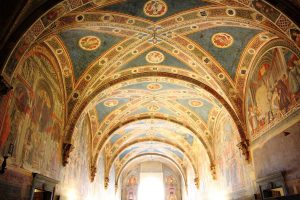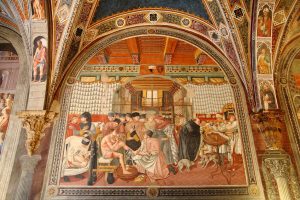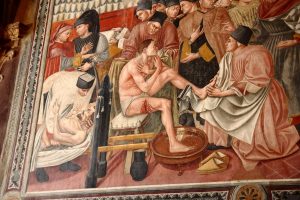By: John David (JD) Ike
As a medical student, much of my time and energy is spent studying the sciences. For the better part of my day, I pour through online resources, question banks and medical journals to learn the facts necessary to succeed on the wards and on the boards. Little to no time is spent discussing the broader implications of medicine on society, the tenets of medical professionalism, and the history of the medical profession. Most importantly, no time is spent discussing the arts – the tangible elements that display and celebrate our shared humanity and highlight our values, beliefs and traditions. As an appreciator of the arts with a research interest in the intersection of visual art and medicine, I found an opportunity to explore this topic as a teaching assistant for an Emory University undergraduate study abroad course in Italy titled, “Medicine, Compassion, and the Arts.” Through literature, art, music and self-reflection, the course seeks to explore the role the humanities play in shaping our understanding of medicine, ethics, professionalism and compassion. During my final weeks on the program, I revisited a piece written by Sarah Candler, MD, one of my colleagues and a former TA on the program, about her experiences titled “Medical Map-Making.”(1)
In her piece, Candler argues that the introspective journey required to map one’s moral boundaries is often a haphazard wandering through difficult quandaries and questions: What are my values? Why do I value these things? Does my lifestyle reflect my principles? What are my responsibilities? She argues that travel often brings to light many of these complex questions by generating contrast; seemingly mundane experiences in one’s home country morph into intense moments of reflection that raise critical questions. Central to her thesis is the belief that “practitioners who are willing to travel, to explore unfamiliar territory in physical as well as emotional space, are better prepared to understand and help out patients as they traverse the bounds of sickness and health.” Through getting to know ourselves on a deeper level and learning where we draw our moral lines in the sand, we can better connect with and treat our patients. Absent from her discussion, however, is the role the arts may play both at home and abroad in raising similar questions. The arts, specifically visual art, provide a lens to simultaneously examine the past, present and future. Through interaction with a painting, a sculpture, or a work of architecture, we can begin to explore a society’s values and belief systems and enter into a metaphysical conversation within ourselves about our own values and beliefs – we can begin to engage our moral imaginations.
To illustrate this concept, consider Santa Maria della Scala, a civic hospital in Siena, Italy, situated directly across the piazza from the central cathedral. Constructed in 1193, the hospital was originally designed to host pilgrims – vagabonds and outcasts with no permanent home – and provide them with shelter, food, and friendship. Later, this space was converted into a formal hospital which offered health services to the poor, pilgrims, orphans, and the sick. In the central entrance hall is an impressive fresco cycle painted in the late 14th century, shortly after the Black Death wiped out much of the European population. The cycle is composed of multiple large-scale frescoes that depict the founding of the hospital, its association with the church, its role in caring for orphaned children, and most important to our conversation, images of healthcare providers intimately caring for the sick and dying.

Central Entrance Hall. Santa Maria della Scala, Siena, Italy
Photo Credit: Sammy Abusrur (M2, USF School of Medicine)
When I walked into this serene and cool space on a sultry summer day in June 2016, I began engaging my moral imagination: If I were a starving and sick pilgrim in the 14th century, what would these frescoes say to me? Would I feel welcomed? As a healthy member of the Sienese society in the 14th century, what would this fresco cycle say about the values of my community? As a 21st century viewer and healthcare provider, what can I infer about the role of the physician in this society? Has this role changed? The fresco cycle is a tour de force that illustrates many instances of true compassion and communicates a message of warming embrace to those in need. It embodies the origins of the word hospital – Ospedale – which means “to host” and demonstrates in each image the meaning of hospitality and kindness. This fresco cycle is powerful and tells a story that still resonates. It affords us an opportunity to draw contrasts and reflect. It is instructive.


Fresco Cycle in Central Entrance Hall of Santa Maria della Scala, Siena, Italy
Photo Credit: Sammy Abusrur (M2, USF School of Medicine)
Juxtapose this welcoming scene with the sterile feel of many US hospitals: overcrowded rooms, walls devoid of art, and a healthcare system that incentivizes institutions to quickly discharge patients into a world they are grossly unprepared to reenter. I cannot help but reflect upon my own feelings as I stroll through the halls of Grady Memorial Hospital in downtown Atlanta, a large “community” hospital that’s design and decoration often communicate sterile institutionalism to patients, visitors and staff. Walking its halls and visiting the many patient rooms makes me wonder, “Is this a place I would come to heal or a place I would rather drop in for quick ‘tune-up’ before retreating to a restorative environment?”
Since my return from Italy, I cannot walk through our constructed healthcare environment without pausing for a moment to reflect. Interacting with Santa Maria Della Scala’s 14th century fresco cycle continues to make me wonder when, in the history of medicine, we lost our ability to host; to welcome with open arms the sick and needy with kindness, shelter and friendship.[1] When did we lose our ability to truly care for those who feel the world has left them to suffer alone? The frescoes remind me that that before we can heal our patients, we must host them. It reminds me that as a medical student, I must see myself in context of the physicians who came and healed before me. I must use the arts as a moral guide to reflect and my actions as a tool to exemplify altruism and care for patients. Such reflection is of utmost importance given the quantifiable decline in empathy experienced by many third year medical students and practitioners as they advance in their training.
Art tells a story. It is a window into the past that simultaneously offers a lens to study the present – a catalyst that sparks reflection. As we enter a community, a museum, a public space, or even a hospital, we should continue to look for and assess the presence or absence of visual art and the messages it communicates about our shared humanity. We must take time to sort through our internal conversations and continually use our moral imaginations to map our values and beliefs. Most of all, we must be prepared to listen to the arts. They may offer us clarity to life’s daunting questions.
References:
- Candler, SG “Medical Map-Making” The New Physician, a publication of AMSA. 2012; 61 (6).
[1] There are niches in today’s healthcare system that are focusing their efforts on hospitality: hospice and VIP/concierge medicine. Hospice medicine and palliative care continues to emphasize comfort as reflected in the American Academy of Hospice and Palliative Medicine’s commitment to diversity, inclusion, and creating a welcoming environment to heal. The growing trend of VIP medicine and concierge medical practice offers luxurious accommodations and locations for the delivery of medical care that simultaneously champions hospitality. One example is Emory University Hospital’s Rollins Pavilion. What remains troubling, however, is that this level of hospitality is not emphasized in standard medical care. Perhaps the age-old adage “community hospital” has become an oxymoron.
Acknowledgements:
Jordan Messler, MD, SFHM
Morton Plant Hospitalists
InCompass Health
Ruth M. Parker, MD
Professor of Medicine, Pediatrics, and Public Health
Emory University School of Medicine
Leigh T. Partington, PhD
Writer Division of Medicine & Geriatrics
Emory University School of Medicine



Leave A Comment